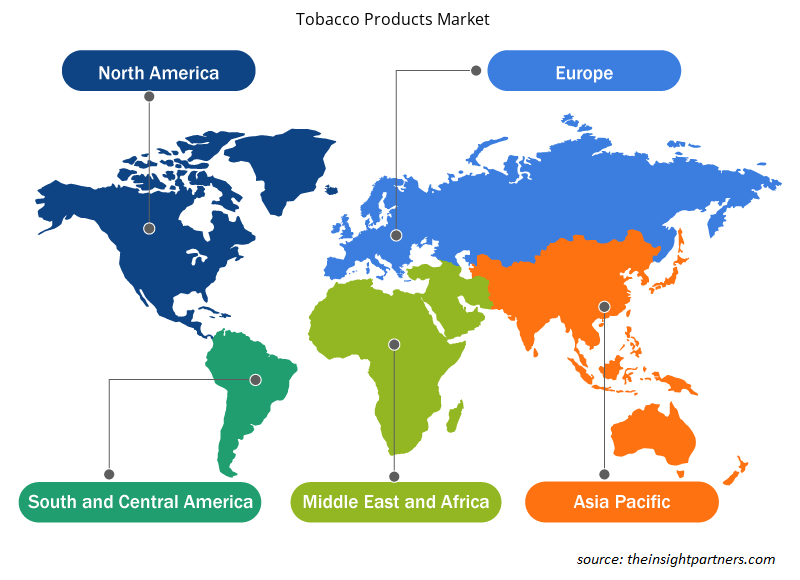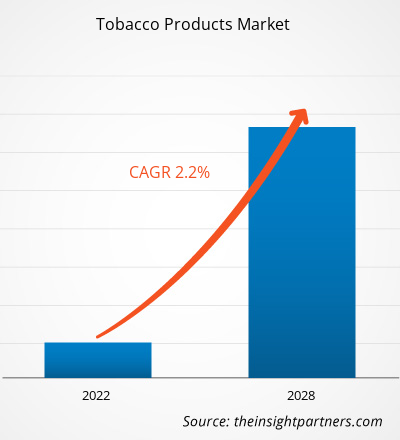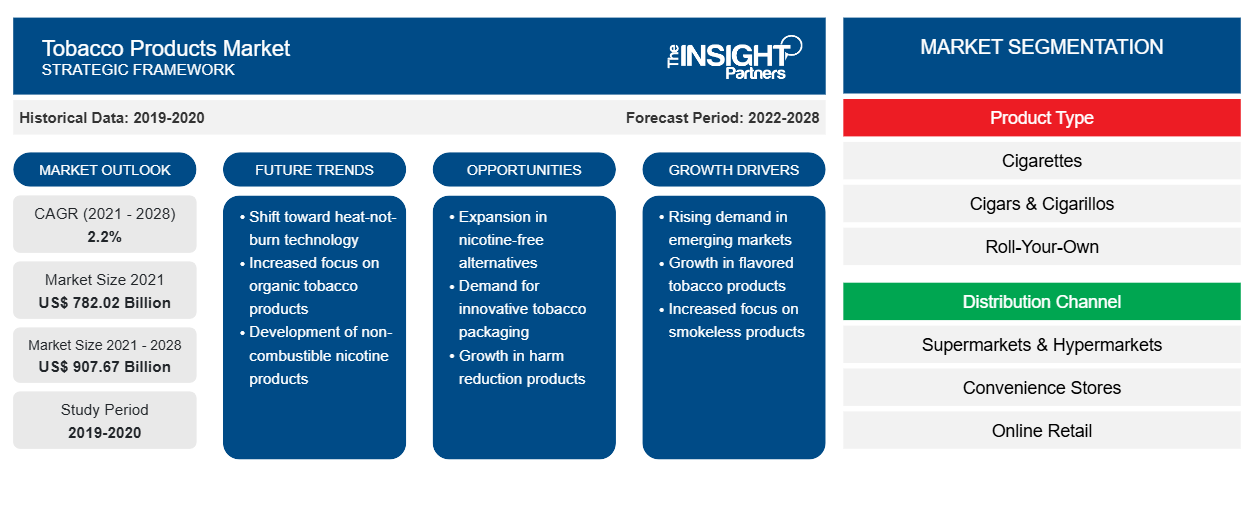Le marché des produits du tabac devrait atteindre 907 665,43 millions USD d'ici 2028, contre 782 022,19 millions USD en 2021. Il devrait croître à un TCAC de 2,2 % de 2021 à 2028.
Les feuilles de tabac de différentes variétés, comme le Virginia et le Burley, sont mélangées pour fabriquer des produits tels que des cigarettes , des cigares et des cigarillos, ainsi que du tabac à rouler. La consommation de tabac et de produits connexes a augmenté dans le monde entier pendant la période de ralentissement économique en raison de la chute des marchés boursiers et des saisies immobilières, ainsi que du stress lié aux licenciements, qui ont poussé de nombreuses personnes à chercher refuge dans le tabagisme. Le tabac est l'une des substances addictives les plus couramment utilisées dans le monde. Il contribue également à la majorité des recettes fiscales de diverses nations des économies développées et en développement.
L'Asie-Pacifique détenait la plus grande part du marché des produits du tabac en 2020, tandis que le Moyen-Orient et l'Afrique devraient enregistrer un TCAC important sur le marché au cours de la période de prévision. Les principaux acteurs opérant sur le marché des produits du tabac étendent leurs opérations au Moyen-Orient et en Afrique en raison de la base de clientèle potentielle, des lois favorables et du développement rapide du paysage de la vente au détail dans la région.
Personnalisez ce rapport en fonction de vos besoins
Vous bénéficierez d'une personnalisation gratuite de n'importe quel rapport, y compris de certaines parties de ce rapport, d'une analyse au niveau des pays, d'un pack de données Excel, ainsi que de superbes offres et réductions pour les start-ups et les universités.
-
Obtenez les principales tendances clés du marché de ce rapport.Cet échantillon GRATUIT comprendra une analyse de données, allant des tendances du marché aux estimations et prévisions.
Impact de la pandémie de COVID-19 sur le marché des produits du tabac
La pandémie de COVID-19 a posé des défis sans précédent à de nombreux secteurs au début de l’année 2020. Les confinements, les restrictions aux frontières, les interdictions de voyager, l’arrêt de la fabrication et d’autres mesures de sécurité mises en place par les gouvernements conformément aux directives de l’OMS et des ministères nationaux de la santé ont entravé les opérations de fabrication. D’autre part, selon des études menées par l’American College of Physicians, au cours des 16 premiers mois de la pandémie de COVID-19, les ventes de cigarettes aux États-Unis ont été plus importantes que prévu. La majorité des fabricants de tabac ont constaté une augmentation de la demande de produits de tabac sans fumée ou chauffés et de produits de tabac à chiquer pendant la pandémie. Cependant, ils ont dû faire face à une légère baisse des ventes au détail en voyage en raison des interdictions de voyager.
Informations sur le marché
La demande croissante de produits du tabac non combustibles stimule la croissance du marché
En raison des préoccupations croissantes en matière de santé liées à la consommation de produits du tabac combustibles, les gouvernements ont encouragé les entreprises à introduire plusieurs lois et réglementations pour contrôler la consommation de tabac. Ils ont augmenté les taxes sur le tabac combustible et baissé les prix du tabac non combustible. Cela a entraîné une plus grande adoption de produits non combustibles, tels que les cigarettes électroniques. Par exemple, le gouvernement britannique a adopté une approche holistique en augmentant considérablement les taxes sur les produits du tabac combustibles et en abaissant celles sur les produits non combustibles. Cela a accru l'adoption des cigarettes électroniques sur le marché britannique, réduisant considérablement les taux de prévalence du tabagisme dans le pays. Les fabricants ont également développé des produits du tabac à usage oral, non combustibles ou sans fumée dans la catégorie des produits à risque réduit (RRP).RRPs) category.
Informations sur les types de produits
En fonction du type de produit, le marché des produits du tabac est segmenté en cigarettes, cigares et cigarillos, tabacs à rouler et autres. Le segment des autres produits du tabac devrait enregistrer le TCAC le plus élevé au cours de la période de prévision. Ce segment comprend les cigarettes électroniques, les vapes, le snus et les solubles. La prise de conscience croissante des méfaits des produits du tabac combustibles stimule la demande de produits du tabac non combustibles, tels que les cigarettes électroniques, les vapes et les produits du tabac à chiquer.
Informations sur les canaux de distribution
En fonction du canal de distribution, le marché des produits du tabac a été segmenté en supermarchés et hypermarchés, magasins de proximité, vente au détail en ligne et autres. Le segment de la vente au détail en ligne devrait enregistrer le TCAC le plus élevé du marché au cours de la période de prévision. La vente au détail en ligne offre une expérience d'achat pratique aux utilisateurs, suivie d'une livraison simplifiée des produits. Les magasins de vente au détail en ligne proposent une large gamme de produits à des prix très réduits ; les consommateurs peuvent également acheter facilement les produits souhaités à distance. Les services de livraison à domicile encouragent un grand nombre de consommateurs à faire leurs achats via les portails de commerce électronique.
Les principaux acteurs du marché des produits du tabac sont Altria Group, Inc. ; British American Tobacco plc ; Swedish Match AB ; ITC Ltd. ; Japan Tobacco International ; Imperial Brands ; Philip Morris Products SA ; Vector Group LTD. ; Pyxus International, Inc. ; et China Tobacco International (HK) Company Limited. Ces acteurs se consacrent au développement de produits présentant des risques réduits pour la santé afin de répondre aux nouvelles tendances de consommation, tout en respectant les cadres réglementaires. Ils participent à des fusions et acquisitions, à des expansions d'entreprises et à des partenariats pour accroître leur part de marché.
Aperçu régional du marché des produits du tabac
Les tendances et facteurs régionaux influençant le marché des produits du tabac tout au long de la période de prévision ont été expliqués en détail par les analystes d’Insight Partners. Cette section traite également des segments et de la géographie du marché des produits du tabac en Amérique du Nord, en Europe, en Asie-Pacifique, au Moyen-Orient et en Afrique, ainsi qu’en Amérique du Sud et en Amérique centrale.

- Obtenez les données régionales spécifiques au marché des produits du tabac
Portée du rapport sur le marché des produits du tabac
| Attribut de rapport | Détails |
|---|---|
| Taille du marché en 2021 | 782,02 milliards de dollars américains |
| Taille du marché d'ici 2028 | 907,67 milliards de dollars américains |
| Taux de croissance annuel moyen mondial (2021-2028) | 2,2% |
| Données historiques | 2019-2020 |
| Période de prévision | 2022-2028 |
| Segments couverts |
Par type de produit
|
| Régions et pays couverts |
Amérique du Nord
|
| Leaders du marché et profils d'entreprises clés |
|
Densité des acteurs du marché des produits du tabac : comprendre son impact sur la dynamique commerciale
Le marché des produits du tabac connaît une croissance rapide, tirée par la demande croissante des utilisateurs finaux en raison de facteurs tels que l'évolution des préférences des consommateurs, les avancées technologiques et une plus grande sensibilisation aux avantages du produit. À mesure que la demande augmente, les entreprises élargissent leurs offres, innovent pour répondre aux besoins des consommateurs et capitalisent sur les tendances émergentes, ce qui alimente davantage la croissance du marché.
La densité des acteurs du marché fait référence à la répartition des entreprises ou des sociétés opérant sur un marché ou un secteur particulier. Elle indique le nombre de concurrents (acteurs du marché) présents sur un marché donné par rapport à sa taille ou à sa valeur marchande totale.
Les principales entreprises opérant sur le marché des produits du tabac sont :
- Groupe Altria, Inc.
- Société britannique de tabac américain plc.
- Match suédois AB
- ITC Ltée.
- Japan Tobacco International
Avis de non-responsabilité : les sociétés répertoriées ci-dessus ne sont pas classées dans un ordre particulier.

- Obtenez un aperçu des principaux acteurs du marché des produits du tabac
Rapports en vedette
- Tendances industrielles progressistes sur le marché des produits du tabac pour aider les acteurs à développer des stratégies efficaces à long terme
- Stratégies de croissance des entreprises adoptées pour assurer la croissance sur les marchés développés et en développement
- Analyse quantitative du marché des produits du tabac de 2019 à 2028
- Estimation de la demande mondiale de produits du tabac
- Analyse des cinq forces de Porter pour illustrer l'efficacité des acheteurs et des fournisseurs opérant dans l'industrie
- Développements récents pour comprendre le scénario concurrentiel du marché
- Tendances et perspectives du marché ainsi que facteurs régissant la croissance du marché des produits du tabac
- Aide à la prise de décision en mettant en évidence les stratégies de marché qui sous-tendent l'intérêt commercial, conduisant à la croissance du marché
- Taille du marché des produits du tabac à différents niveaux
- Aperçu détaillé et segmentation du marché et dynamique de l' industrie du tabac
- Ampleur de la croissance dans diverses régions présentant des opportunités de croissance prometteuses
- Analyse historique (2 ans), année de base, prévision (7 ans) avec TCAC
- Analyse PEST et SWOT
- Taille du marché Valeur / Volume - Mondial, Régional, Pays
- Industrie et paysage concurrentiel
- Ensemble de données Excel
Rapports récents
Témoignages
Raison d'acheter
- Prise de décision éclairée
- Compréhension de la dynamique du marché
- Analyse concurrentielle
- Connaissances clients
- Prévisions de marché
- Atténuation des risques
- Planification stratégique
- Justification des investissements
- Identification des marchés émergents
- Amélioration des stratégies marketing
- Amélioration de l'efficacité opérationnelle
- Alignement sur les tendances réglementaires























 Obtenez un échantillon gratuit pour - Marché des produits du tabac
Obtenez un échantillon gratuit pour - Marché des produits du tabac